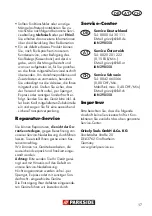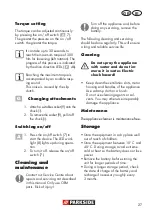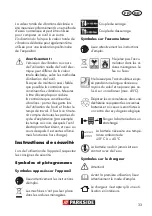
22
GB
IE
3) PERSONAL SAFETY
a) Stay alert, watch what you are
doing and use common sense
when operating a power tool.
Do not use a power tool while
you are tired or under the influ
-
ence of drugs, alcohol or medi-
cation.
A moment of inattention white
operating power tools may result in
serious personal injury.
b) Use personal protective equip-
ment. Always wear eye protec-
tion.
Protective equipment such as
dust mask, non-slip safety shoes, hard
hat, or hearing protection used for
appropriate conditions will reduce per-
sonal injuries.
c) Prevent unintentional starting.
Ensure the switch is in the off-po-
sition before connecting to power
source and/or battery pack,
picking up or carrying the tool.
Carrying power tools with your finger on
the switch or energising power tools that
have the switch on invites accidents.
d) Remove any adjusting key or
wrench before turning the pow-
er tool on.
A wrench or a key left at-
tached to a rotating part of the power
tool may result in personal injury.
e) Do not overreach. Keep proper
footing and balance at all times.
This enables better control of the power
tool in unexpected situations.
f) Dress properly. Do not wear
loose clothing or jewellery. Keep
your hair, clothing and gloves
away from moving parts.
Loose
clothes, jewellery or long hair can be
caught in moving parts.
g) If devices are provided for the
connection of dust extraction
and collection facilities, ensure
these are connected and prop-
erly used.
Use of dust collection can
reduce dust-related hazards.
4) POWER TOOL USE AND CARE
a) Do not force the power tool.
Use the correct power tool for
your application.
The correct pow-
er tool will do the job better and safer
at the rate for which it was designed.
b) Do not use the power tool if the
switch does not turn it on and
off.
Any power tool that cannot be
controlled with the switch is dangerous
and must be repaired.
c) Disconnect the plug from the
power source and/or the bat-
tery pack from the power tool
before making any adjust
-ments, changing accessories,
or storing power tools.
Such pre-
ventive safety measures reduce the risk
of starting the power tool accidentaIly.
d) Store idle power tools out of
the reach of children and do not
allow persons unfamiliar with
the power tool or these instruc-
tions to operate the power tool.
Power tools are dangerous in the
hands of untrained users.
e) Maintain power tools. Check
for misalignment or binding
of moving parts, breakage of
parts and any other condition
that may affect the power tool’s
operation.
If damaged, have the
power tool repaired before use. Many
accidents are caused by poorly main-
tained power tools.
f) Keep cutting tools sharp and
clean.
Properly maintained cutting
tools with sharp cutting edges are less
Iikely to bind and are easier to control.
Summary of Contents for PHSSA 12-Li A1
Page 3: ...1 2 3 5 14 6 8 5 5 6 10 10 11 12 12 13 13 9 7 15 16 4...
Page 106: ...106...
Page 108: ...108 20180608_rev02_mt...
Page 110: ...9 1 15 2 4a 4b 15a...
Page 111: ......














































